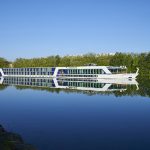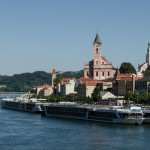Whether a river has high or low water levels is something you’re unlikely to consider when planning your river cruise.
Unlike ocean cruises, river cruises operate in the margins. The depth of water underneath the keel, or bottom, of your ship can be less than a foot in many instances. Low bridges, power lines, and other navigational obstacles restrict the height of a vessel.
Thus, river cruise ships have a very narrow margin in which to operate; a sweet spot where the water isn’t so low that the hull touches bottom, and not so high that bridges and overhead obstructions become impassable.

While it isn’t discussed as often as water levels on the Danube and the Rhine, high and low water levels can affect your river cruise along Portugal’s Douro River – though it’s admittedly not quite as susceptible to these events as other European waterways.
The Douro has some help, though, in avoiding water level-related snafus. There are five locks positioned along its length that help ships transit to other levels and control the flow of the water downstream, aided by the region’s climate that tends to be dry and hot for the summer months.
Also aiding Douro river cruises in proceeding as scheduled is the fact that many ports of call are positioned geographically close to one another. Unlike a river cruise that is scheduled to sail between Amsterdam and Budapest, the distances that have to be sailed on a Douro river cruise are minimal. This enables operators to use motorcoaches to complete the itinerary as scheduled, while still allowing guests to continue to use their floating accommodations each evening.
When Water Levels Don’t Cooperate

Still, events have occurred in the past. Unseasonably heavy rainfall in April and September a few years ago resulted in itinerary changes and modifications, most of which were conducted by utilizing motorcoaches to complete the journey.
These changes are frustrating for travellers, many of whom only learn that there is a problem with their river cruise after arriving in Europe, ready to start their holiday. On sounding boards like TripAdvisor, many disgruntled river cruisers wonder publicly why they weren’t informed prior to their international flights, suggesting that, given the choice, they’d opt to cancel and take a refund or another sailing date.
In almost all cases, water levels are so fickle that they can change by the hour. A river cruise that is possible one week can change on a dime, becoming problematic for the following sailing. The inverse is true: just because a sailing is having to operate with adjustments and modifications one week doesn’t mean that the following weeks will be the same.
Because of this, many river cruise lines don’t know until almost the last minute how your sailing will – or won’t – be affected. On one memorable sailing down the Danube, we only found out halfway through our voyage that the passage from Nuremberg to Passau was impossible; we’d have to ‘swap-ships’ (more on that later) to complete our journey. On another instance, on a Christmas Markets river cruise through Germany, the water level made us too high to clear a bridge blocking our path by mere inches. The crew got out the tape measurer and waited it out until the water had slackened enough to allow us to pass unscathed. No one knew it was a problem until our departure.
So what can you do when water levels threaten to scuttle your river cruise? The old travel adage, “forewarned is forearmed”, is very appropriate. Here are a few things you should know about taking any river cruise, not just one operating along the Douro:
What To Do When Water Levels Threaten Your Cruise

Chances are good that your Douro river cruise will proceed exactly as expected – but there are some things that are good to know about these water-related events, and what to do should one arise.
History isn’t a good indicator of high or low water. Just because one year was affected by abnormally-heavy rainfall doesn’t mean the following one will be identical. Don’t let people (or past reviews) put you off unnecessarily.
What happens if high/low water levels affect my sailing? River cruise lines will typically attempt to keep your itinerary as operational as possible. Generally, when high/low water levels hit the Douro, three options are available to cruise lines:
- Continue the affected itinerary by having guests ‘swap ships’ – typically, being bussed from one town to the next, where you will embark a sister-ship or similar vessel to continue the rest of your journey. On the Douro, this option is really only open to companies like CroisiEurope and Viking River Cruises that operate more than one vessel in the region.
- If things are bad enough (like during the once-in-a-century flooding that occurred along the Danube in 2013), your river cruise might turn into a bus trip as the cruise line attempts to do its best to hit all the major sights and attractions along the way. This usually involves putting guests up in hotels – on the cruise line’s dime – and arranging for coach transportation and guides that weren’t originally needed. It’s a huge logistical nightmare, and one that is guaranteed to displease some. We can sympathize; after all, if we liked coach tours, we’d call our site Bus Tour Advisor. On the plus side: you’re still in Europe, and can still enjoy nearly all the fantastic things you would have on the river cruise, at no additional cost to you.
- Outright cancellation. This is the rarest option, exercised when no other alternatives are available.
Other Factors
One of the less-mentioned issues facing Douro river cruises is fire. Massive wildfires swept through the region during the summer of 2017, with columns of smoke choking skies and water bombers roaring overhead in an attempt to control the blaze. All this while temperatures soared past 50 degrees Celsius (122 Fahrenheit). While the 2017 season was abnormally large, hot and dry summers create all the necessary conditions for potentially devastating wildfires.
Going With the Flow

It sounds cheesy, but the best thing you can do should the unexpected arise is to go with the flow. Getting angry, yelling at staff or threatening the cruise line rarely fails to accomplish much, as the issue is almost entire out of their control. Consider this, too: this could have been one of several sailings that the crew has had to deal with so far this season. Unlike you, they don’t get to leave – instead, they’re treated to greeting busloads of unhappy guests week after week. Try to put yourself in their shoes as much as possible.
We speak from experience. While we haven’t been delayed or inconvenienced on the Douro (other than one very wet, damp mid-March sailing), but we have experienced both high and low water events on all stretches of the Danube, the Rhine, the Main, and even the Mekong, which was swollen to an unbelievable height during a cruise a few years back that resulted in messy disembarkations at every port of call.
These events are inconvenient, but it is important to remember that they aren’t all that likely to happen, and certainly not all the time. It’s a bit like experiencing a flight delay at the airport: you can fly dozens of times successfully, but the one that was horrifically delayed or cancelled is the one that sticks out in most people’s minds.
The fact of the matter remains that the vast majority of Douro river cruises will be completed without a hitch. So don’t stress about the ‘what-if’s; be excited about your amazing journey through the vineyards and history of Portugal. And remember: a nice glass of wine is never out of reach on this journey.
See our featured river cruise sailings >>
Talk with Teresa Skeim who has over 30 years experience for more ideas planning your trip >>



